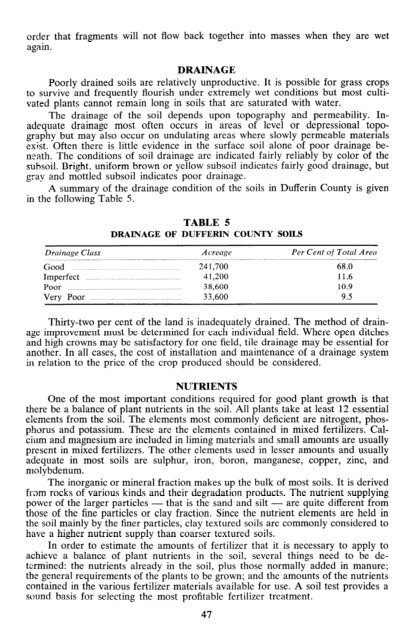Untitled - Agriculture and Agri-Food Canada
Untitled - Agriculture and Agri-Food Canada
Untitled - Agriculture and Agri-Food Canada
You also want an ePaper? Increase the reach of your titles
YUMPU automatically turns print PDFs into web optimized ePapers that Google loves.
order that fragments will not flow back together into masses when they are wet<br />
again.<br />
DRAINAGE<br />
Poorly drained soils are relatively unproductive. It is possible for grass crops<br />
to survive <strong>and</strong> frequently flourish under extremely wet conditions but most cultivated<br />
plants cannot remain long in soils that are saturated with water.<br />
The drainage of the soil depends upon topography <strong>and</strong> permeability. Inadequate<br />
drainage most often occurs in areas of level or depressional topography<br />
but may also occur on undulating areas where slowly permeable materials<br />
exist. Often there is little evidence in the surface soil alone of poor drainage beneath.<br />
The conditions of soil drainage are indicated fairly reliably by color of the<br />
subsoil. Bright, uniform brown or yellow subsoil indicates fairly good drainage, but<br />
gray <strong>and</strong> mottled subsoil indicates poor drainage.<br />
A summary of the drainage condition of the soils in Dufferin County is given<br />
in the following Table 5.<br />
TABLE 5<br />
DRAINAGE OF DUFFERIN COUNTY SOILS<br />
Drainage Class Acreage Per Cent of Total Area<br />
Good 24 1,700 68.0<br />
Imperfect 4 1,200 11.6<br />
Poor 38,600 10.9<br />
Very Poor 33,600 9.5<br />
Thirty-two per cent of the l<strong>and</strong> is inadequately drained. The method of drainage<br />
improvement must be determined for each individual field. Where open ditches<br />
<strong>and</strong> high crowns may be satisfactory for one field, tile drainage may be essential for<br />
another. In all cases, the cost of installation <strong>and</strong> maintenance of a drainage system<br />
in relation to the price of the crop produced should be considered.<br />
NUTRIENTS<br />
One of the most important conditions required for good plant growth is that<br />
there be a balance of plant nutrients in the soil. All plants take at least 12 essential<br />
elements from the soil. The elements most commonly deficient are nitrogent, phosphorus<br />
<strong>and</strong> potassium. These are the elements contained in mixed fertilizers. Calcium<br />
<strong>and</strong> mapesium are included in liming materials <strong>and</strong> small amounts are usually<br />
present in mixed fertilizers. The other elements used in lesser amounts <strong>and</strong> usually<br />
adequate in most soils are sulphur, iron, boron, manganese, copper, zinc, <strong>and</strong><br />
molybdenum.<br />
The inorganic or mineral fraction makes up the bulk of most soils. It is derived<br />
from rocks of various kinds <strong>and</strong> their degradation products. The nutrient supplying<br />
power of the larger particles - that is the s<strong>and</strong> <strong>and</strong> silt - are quite different from<br />
those of the fine particles or clay fraction. Since the nutrient elements are held in<br />
the soil mainly by the finer particles, clay textured soils are commonly considered to<br />
have a higher nutrient supply than coarser textured soils.<br />
In order to estimate the amounts of fertilizer that it is necessary to apply to<br />
achieve a balance of plant nutrients in the soil, several things need to be determined:<br />
the nutrients already in the soil, plus those normally added in manure;<br />
the general requirements of the plants to be grown; <strong>and</strong> the amounts of the nutrients<br />
contained in the various fertilizer materials available for use. A soil test provides a<br />
sound basis for selecting the most profitable fertilizer treatment.<br />
47

















